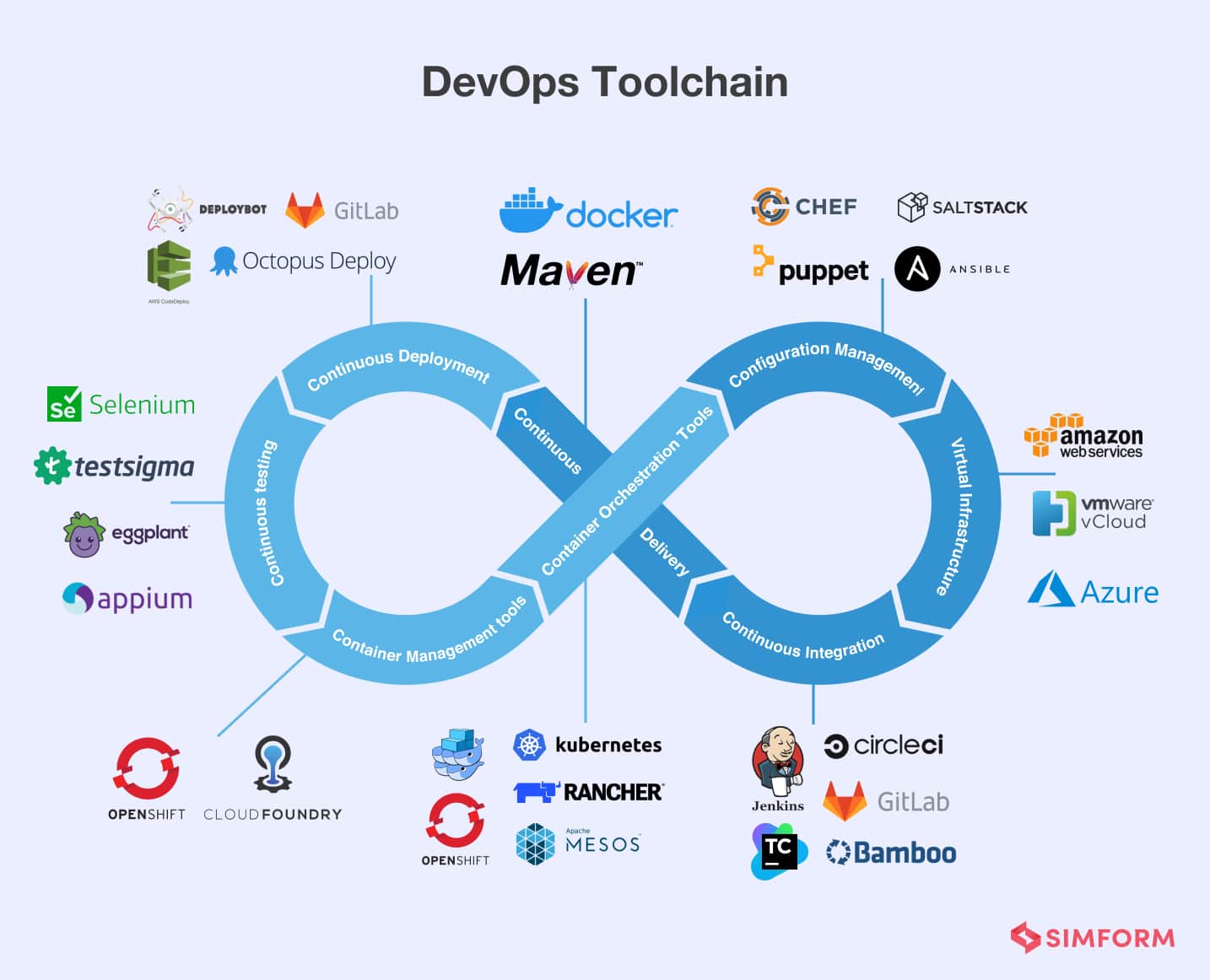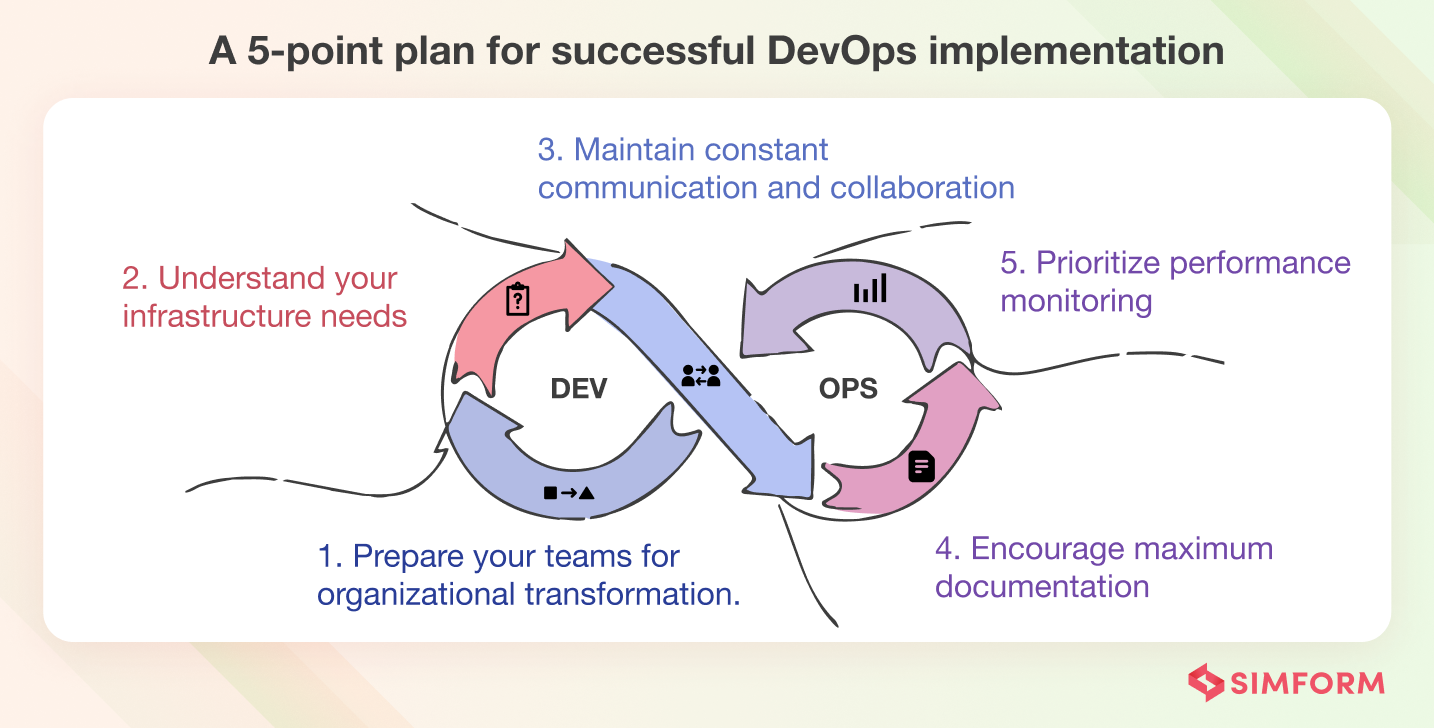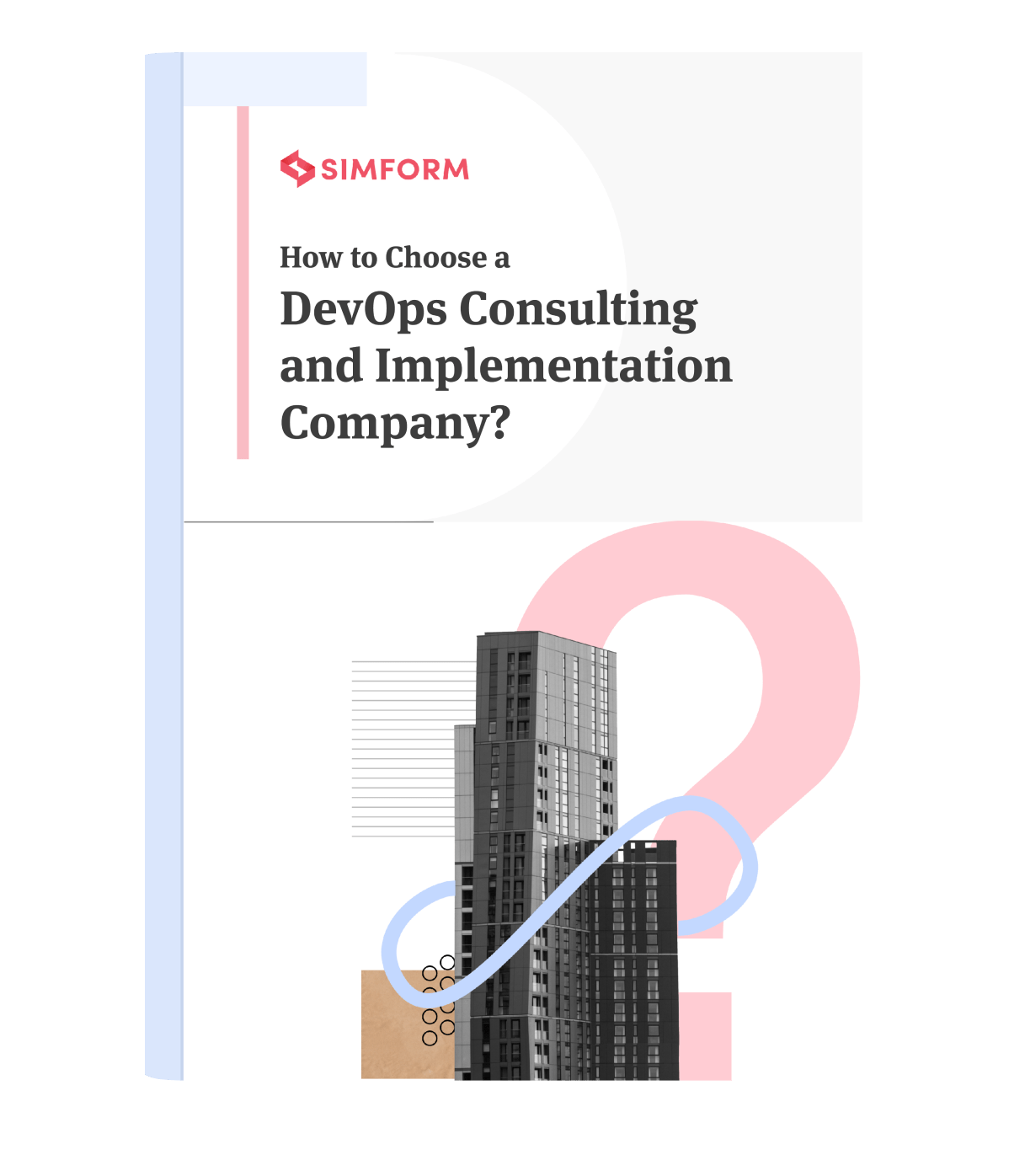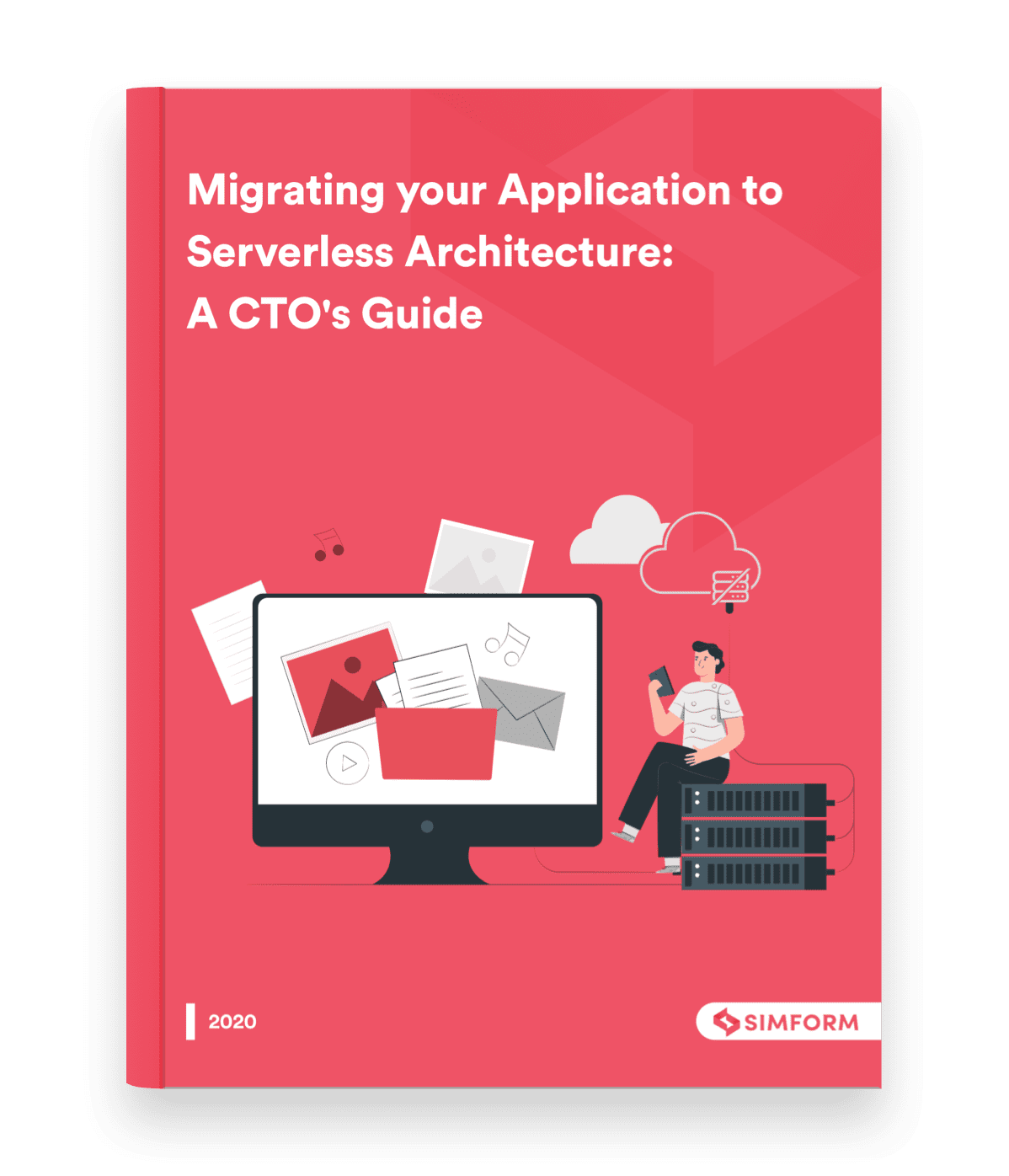A decade ago, when Facebook introduced practices such as code ownership, automation, continuous improvement, and incremental changes to its development process, DevOps had yet to make an entrance in the development world.
In 2015, Starbucks shifted from waterfall practices to Scrum and adopted a push mentality that required the development teams to deliver codes to testing teams before reaching the final stage. This practice, quite unexpectedly, nudged Starbucks into embracing DevOps.
Disney, in 2011, transitioned from functional teams that followed one line of business to a matrix team organizational model that included a core DevOps team. This team proved to be a common connecting point for the technical staff and the business units to function homogeneously.
The bottom line is that there’s no one-size-fits-all solution to DevOps implementation.
DevOps is a flexible approach that combines various cultural philosophies, tools, and practices to bring agility, efficiency, and high velocity to the traditional software development processes and releases. Over the years, tech giants worldwide have tried and tested various methodologies and strategies to integrate them into their ecosystems. While some failed, many have successfully laid a foundation for DevOps implementation.
This article explains the DevOps best practices that organizations must observe while implementing DevOps, how to build a robust toolchain to support the implementation process, and finally discusses the future of DevOps.
A 5-point plan for successful DevOps implementation
Prepare your teams for organizational transformation.
People are critical to making DevOps implementation a success. George Spafford, Senior Director Analyst at Gartner, explains, “Organizational learning and change are key to allowing DevOps to flourish. In other words, people-related factors tend to be the greatest challenges — not technology.”
Naturally, the first step while adopting the DevOps approach in your organization must be to bring development and operations teams at the same stage. It starts with explaining to the teams why the organization expects them to follow the new system, how it will benefit their overall output, and how it will ultimately help improve the business value.
Similarly, allow your teams to take baby steps toward completely accepting DevOps and find ways to drive maximum collaboration and communication by implementing Lean and Agile practices. More importantly, invest in developing the skills your teams require to work more efficiently in cross-functional teams and maintain periodic reviews to track the success of your implementation plan.
For instance, Target wanted to build an accelerated learning environment for their teams–popularly known as “the Dojo”–to integrate DevOps into their ecosystem successfully. So the company introduced an immersive, six-week session where the teams performed their daily tasks with the help of agile coaches, who helped them with valuable insights from the DevOps point of view.
While explaining the success of this initiative, Mike McNamara, CIO at Target, says, “The Dojo has been fantastic in getting teams engaged with agile and DevOps, removing the natural resistance and fear of change, and then supporting the team through the changes while maintaining productivity. It’s been a huge success for Target.”
Understand your infrastructure needs
The next important step involves understanding your application and its needs on a deeper level. It enables you to align the infrastructure design with your organizational goals and make DevOps implementation business-driven.
Assess your project release cycle and testing environments to identify areas for improvement and potential bottlenecks. A successful DevOps implementation is incomplete without incorporating Continuous Integration and Continuous Delivery pipelines into your workflow. Why? Because Continuous Integration allows your development teams to develop a product in small, regular stages and identify and repair errors immediately, while Continuous Delivery enables them to deploy these changes in production.
Let’s look at the example of Capital One, a leading financial services company in the USA and the first major bank to host its banking application on the public cloud. It decided to leverage the AWS infrastructure to build a DevOps strategy, not just for the technical teams but also for the business product management team.
John Andrukonis, the former Chief Architect at Capital One, talks about how adopting cloud infrastructure helped the company achieve great success at DevOps implementation, “Now that we’re using DevOps, our developers feel even more ownership of these products and are empowered to get proactive about uptime, supportability, and monitoring. DevOps on the cloud is helping designers, developers, and engineers work together to make the customer experience better and better.”
Maintain constant communication and collaboration
DevOps is more than picking the right tools and methodologies. Communication lies at the heart of its implementation process. Therefore, you must encourage dialogue between team members at every stage of the development.
One way to achieve this is by introducing open-source communities, such as GitLab, to provide your teams with a global platform to collaborate, plan, develop, verify, and release software. However, what matters more is that your teams understand empathy and mutual responsibility towards each other and the project. Why is this important? It enables operations teams to realize the significance of faster releases and developers to perceive the issues resulting from bad codes. As a result, both the teams work towards a common goal and focus on 100% user satisfaction. Additionally, organizations should promote a knowledge-sharing environment that depicts what works, what doesn’t, and how to improve it from the business perspective.
When Microsoft was on its journey to implement DevOps in its development ecosystem, it realized the importance of streamlining developer collaboration and decided to offer its teams a common developer platform. As a result, the company open-sourced .Net framework and leveraged it for Microsoft teams to innovate and collaborate better.
Encourage maximum documentation
Maintaining proper documentation is a practice that is often overlooked but can prove to be a time-saver in an agile environment. Encourage teams to document the entire DevOps strategy, including the process, infrastructure, performance reports, detailed analysis of change management, and RCA (Root Cause Analysis).
However, it’s not always simple.
Typically, in an agile development project, the initial iterations occur within a few weeks of release and are eventually followed by bug fixes, new features, or other improvements in the functionality. It is, therefore, essential to foster the habit of documentation to allow users, developers, and operations teams to understand the product better. Such practices also help overcome the intricacies of traditional documentation strategy.
Walmart is one of the best examples to understand the significance of why documenting is vital for organizations. The company successfully adopted a DevOps model to automate and accelerate its deployments and created various open-source tools. In addition, it encouraged the development teams to concentrate on writing reusable application logic rather than spending countless hours building an infrastructure.
The lesson we must learn from Walmart is to start documentation from the start of every iteration, which allows your teams to polish the records by the end of the project and ensure that no details get lost in translation. The following important rule is to avoid silos–between writers, developers, testers, and operations teams–and promote a collaborative effort in documenting.
Additionally, keep a documentation outline/template to make it easier for the teams to make entries without spending too much time ascertaining the proper format.
Prioritize performance monitoring
Continuous Monitoring is essential while implementing DevOps, especially in an automated environment. It helps organizations understand if the application performs at the desired capacity and offers transparency to the entire process.
The first step involves setting performance metrics to measure the progress and fix any defects detected during monitoring. These metrics should include speed, resource utilization, quality, crash rate, scalability, availability, and user feedback.
But is it possible to monitor every service and procedure? Unfortunately, no.
Therefore, it is paramount to understand your primary monitoring targets clearly. They can include but are not limited to the efficient functioning of the CI/CD pipeline, server health, user activity, overall application performance, deployment goals, and automated handling of vulnerabilities.
One of the pioneers in DevOps implementation, Etsy has successfully built a CI/CD pipeline on top of Jenkins capable of executing 14,000 test suites each day. Realizing the need for monitoring this platform, the company developed Kale, a monitoring system that detects every anomaly by monitoring every deployment. This system ensures that the application is stable and healthy before it’s available for the users.
By now, we know that DevOps is not a technology but a development practice that depends on two principles– continuous integration and continuous delivery. While implementing DevOps, multiple teams collaborate and share their resources to achieve a common end goal. Although DevOps principles offer tremendous flexibility in its implementation, these teams must have a robust set of tools at their disposal to eliminate silos and keep conflicts at bay.
But, how do you achieve it?
Click here to read the entire case study on FIH website development
Make implementation simpler with a DevOps toolchain
What is the DevOps toolchain?

As the term suggests, it’s a set of tools that assists different teams to develop, deliver, and maintain software according to the rules of Agile. It combines various open-source tools that align with the needs of designers, developers, testers, operations, and other teams to complete and simplify complicated tasks of the development process and enables businesses to build a healthy development pipeline for software releases.
To optimize a DevOps toolchain, it should align with your development pipeline, and your teams must have access to tools for each of these processes:-
- Planning
- Collaboration
- Source control
- Tracking and escalating issues
- Configuration management
- Continuous integration
- Monitoring
- Test and automation
- Deployment
- Repository management
How to build a DevOps toolchain?
The main objective of building a toolchain is to make it compatible with the standardization of your DevOps framework. In addition, it should seamlessly integrate with other DevOps tools and processes so that the development teams can follow a similar and consistent workflow. Therefore, it’s safe to say that the smooth functioning of a development pipeline largely depends on choosing the right tools that will form part of the toolchain.
There are two methods of building a toolchain – integrating a standard toolchain or a custom solution. Naturally, there are pros and cons to both approaches.
If you adopt a standard toolchain, you must select suitable tools from a set of pre-orchestrated tools and tailor them to your needs. On the other hand, a custom solution gives you the freedom to orchestrate tools that align with your development pipeline and avoid vendor lock-in. However, you may have to pay higher costs and leverage a non-standardized solution.
To narrow it down – whether you opt for a custom solution or a standard one, building a healthy toolchain is critical.
What is the significance of building a healthy toolchain?
The ultimate aim of implementing DevOps and building a toolchain is to deliver high-quality software, and a healthy toolchain will ensure consistently outstanding results. That’s because it is built to facilitate continuous integration, continuous delivery and leverages automation and error-checking tools to leave no room for mistakes and more opportunities for innovation.
After nearly two decades of inception, the DevOps model is a popular choice for organizations to scale their businesses and improve workflows. As a result, we have access to newer forms of DevOps with enhanced qualities and practices, making it all the more ideal. Here’s a quick rundown of what’s in store for DevOps in the years to come.
What’s next for DevOps?
1. DevSecOps
DevSecOps–short for development, security, and operations–refers to integrating and automating security at every stage of the development lifecycle. From initial designing to developing, testing, and software delivery, this approach encourages integrating security practices as early as possible.
Why is it better than traditional security practices? This approach represents adding security naturally and essentially in software development, unlike traditional development projects that require a dedicated security team and QA team to make the product safe for its users. Moreover, DevSecOps seamlessly integrates app and infrastructure security with DevOps and Agile tools and processes. This practice enables development teams to identify security issues as and when they arise and repair them when it’s simpler, faster, and significantly less costly.
As cybersecurity evolves to be a key concern for organizations, DevSecOps enjoys the patronage of stakeholders owing to improved speed and agility for security teams, timely detection of vulnerabilities in the code, and better cloud service deployments with enhanced security protocols that it delivers. It is, therefore, not surprising that the global DevSecOps market is expected to reach $17.16 billion by 2027.
Here’s how Lisa Azevedo, founder, and CEO of Containn, explains the future of DevSecOps, “DevOps and security teams will use intelligence-based code solutions to automatically build secure infrastructure, replacing manual attempts to fix vulnerabilities. Teams won’t have to spend limited financial and personnel resources building secure infrastructures.”
2. DevOps + AIOps
AIOps stands for artificial intelligence for IT operations and refers to the usage of artificial intelligence that enhances and automates IT operations. This approach leverages Machine Learning (ML) to help organizations quickly monitor and analyze real-time complex streaming data to identify potential bottlenecks.
As businesses aim for digital transformation, factors like increasing quantities of data, scalability, security threats, compliance requirements, and rapidly evolving technologies pose a challenge in their journey to success.
David Linthicum, chief cloud strategy officer at Deloitte Consulting, highlights the benefits of using AIOps in such scenarios, “The advantages of leveraging AIOps as part of the DevOps toolchain includes toolchain to leverage automated operational feedback from AIOps tools, including root-cause analysis and data consolidation/aggregation, that allows organizations to summarize gigabytes of operational data and direct that back to developers for application improvement, as well as to the automated DevOps systems such as testing, integration, and deployment.”
In conclusion, AIOps will enable your teams to process data faster and derive new insights, which helps stakeholders to make data-driven decisions. Ultimately, your IT operations are in a better position to predict and remediate performance issues with more efficiency.
3. DataOps
Gartner defines DataOps as collaborative data management practice focused on improving the communication, integration, and automation of data flows between data managers and data consumers across an organization. This approach automates the design, deployment, and management of data delivery and leverages metadata to enhance data usability in a dynamic environment.
DataOps is born out of two popular practices: DevOps and Agile, to ease and accelerate data analytics deliverability and combines unique tools, processes, and teams. For organizations aiming to bring agility, orchestration, and control throughout the development process, DataOps can be a game-changer.
Explore Our DevOps Implementation Services
Become the next DevOps leader with Simform
DevOps strategy calls for an organizational shift in terms of culture, technologies, tools, and practices. However, forming the right strategy depends on your organization’s strengths and weaknesses. Therefore, choosing a suitable technology partner to guide you through every step of the process is imperative. That’s where we step in!
With 11 years of experience, Simform has evolved as a DevOps partner for organizations. Our experts will recommend the right tools, practices, and methodologies to help your organization make the most of DevOps and Agile and help you improve your business value significantly.
If you have any questions, queries, or suggestions about DevOps adoption and implementation, we’d be happy to assist you!




